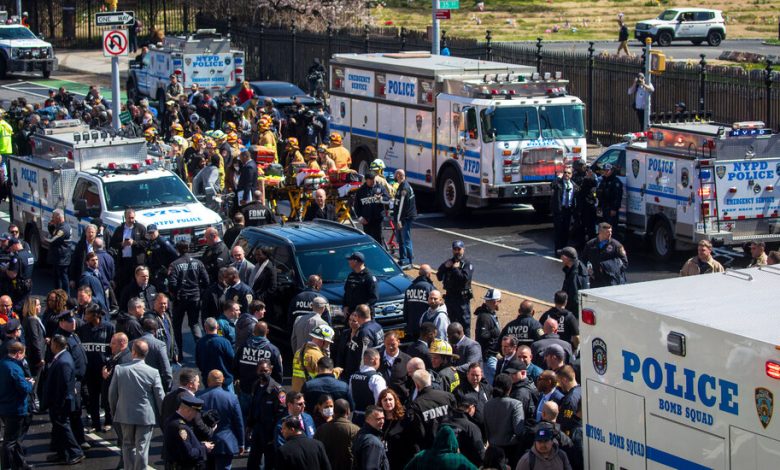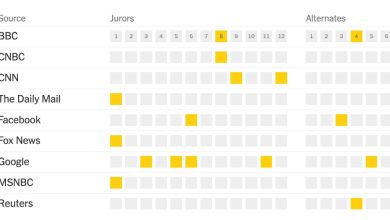The Brooklyn Subway Shooter Faces Sentencing on 10 Terrorism Counts

Frank James, who last year positioned himself in a subway car to create a “kill funnel” and then unleashed a barrage of bullets that miraculously killed no one, is set to be sentenced in a federal court in Brooklyn on Thursday.
Mr. James, who walked away after the crime, had pleaded guilty to 10 counts of terrorism in January, one for each person shot in the attack, which unfolded on a busy N train during the morning rush hour on April 12, 2022. All the victims survived, albeit with long-lasting injuries and psychological damage. The government asked the judge to sentence Mr. James, who is 64, to 10 concurrent life sentences, while the defense sought 18 years.
In an order Tuesday, Judge William F. Kuntz II noted that Mr. James had previously refused to attend court hearings, and directed federal marshals to “use all necessary force” to get him into the courtroom.
The attack paralyzed south Brooklyn and intensified citywide anxiety about violence in the subways. The investigation was initially complicated by the failure of surveillance cameras in the 36th Street station at the time of the shooting, though images of Mr. James were captured by cameras elsewhere in the system. Since the attack, the Metropolitan Transportation Authority and Gov. Kathy Hochul have pledged to add more cameras to stations and to place them inside subway cars.
‘Prolonged Planning’
In a memo to Judge Kuntz, the prosecutors Sara Winik and Ellen Sise argued for 10 concurrent life sentences. They also asked for an additional 120 months, for a gun charge to which Mr. James also pleaded guilty.
They argued that Mr. James had done “careful and prolonged planning.”
The morning of the attack, Mr. James drove a rented truck to Brooklyn and boarded an N train. He wore a yellow hard hat and orange reflective jacket, apparently as a disguise. He dissuaded other passengers from sitting near him and positioned himself at the end of the car, creating a “kill funnel” into which he could shoot without anyone wresting the weapon from him, the prosecutors wrote.
Around 8:30 a.m., while the Manhattan-bound train waited in the tunnel to pull into the 36th Street station, Mr. James set off a smoke grenade, pulled a Glock handgun and fired 32 times. An extended magazine allowed him to avoid reloading, but he had to pull the trigger each time, according to the government. He stopped only when the gun jammed, leaving him unable to use the three dozen other bullets he had packed.
His victims sprawled on the platform at 36th Street, and M.T.A. workers shouted for people to board a train across the platform. There was no surveillance footage of the chaotic scene, because the cameras were not working. Mr. James blended in among the crowd, and exited from the next station.
He had left behind a wealth of evidence, including a bag containing the firearm, which he had purchased in Ohio, gasoline, a torch, a U-Haul key and bank cards in his name. He was identified that day, but evaded police for about 30 hours, even as the authorities were circulating his name and photograph.
He was arrested about 2 p.m. the following day, after several people — including Mr. James himself, according to his lawyer — tipped off the police about his location in the East Village.
When Mr. James pleaded guilty, he said that he only sought to harm, not kill. But prosecutors said that was false, arguing that the sentence should be increased based on his statement, because it constituted perjury. The acceptance of responsibility is a major factor under federal sentencing guidelines, and will likely figure into Judge Kuntz’s decision.
Dying Inside
The defense countered that Mr. James has been severely mentally ill for his entire adult life, suffers from many ailments, and would almost certainly die behind bars.
His court-appointed lawyer, Mia Eisner-Grynberg of the Federal Defenders, wrote that he was unlikely to receive quality medical care in a prison. The defense proposal of an 18-year sentence, “vastly outpaces his life expectancy,” she wrote.
Ms. Eisner-Grynberg painted a dark portrait of Mr. James’s life as she argued for leniency, writing that Mr. James was “tormented by lifelong paranoid schizophrenia” and that he had “snapped” on the morning of the attack. He had first been given powerful psychiatric drugs as a teenager to stop hallucinations, she wrote, but had not received appropriate care over decades of vagrancy and struggle.
“His internal pot simmered until it finally boiled over, leaving catastrophe in its wake,” she wrote.
March of the Cameras
The 36th Street station was supposed to have cameras livestreaming footage to the N.Y.P.D. and NYC Transit Security. But the system had been down four days when the train carrying Mr. James and his terrified victims rolled in.
An M.T.A. inspector general’s report released in December found the people monitoring the system were undertrained, equipment was maintained improperly, and teams were not communicating well. New York City Transit, the division of the M.T.A. that runs the subways, pledged to add new hires, fill vacancies and overhaul its practices.
Five months after the attack, Governor Hochul said that the M.T.A. would install two security cameras on each one of the roughly 6,500 subway cars in the system by 2025. The agency says it is making progress, with 1,142 installed so far. The total cost was pegged at $5.5 million. Some of the new cameras can be viewed in real time by train crews during emergencies.
The transit authority says it has added about 1,370 cameras in its 472 stations since the attack, bringing the total to about 11,670. Speaking at a news conference last month, the agency’s president, Richard Davey, said the system has “more cameras than a Las Vegas casino.”
Watchdogs have raised concerns about implications for privacy, as well as the cost, but Michael M. Kemper, the chief of the transit police, said in an interview that the new cameras are essential in deterring, investigating and prosecuting crime.
“We’re all for video,” he said. “So are the prosecutors and so are the juries and so are the judges.”




